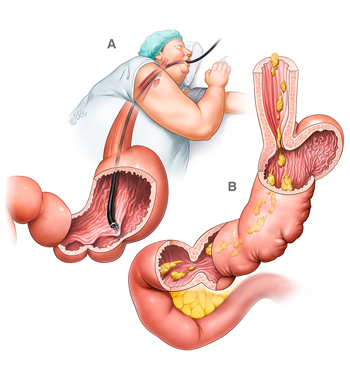Other bariatric procedures
Some operations have a direct metabolic effect on diabetic control. These are sleeve gastrectomy, bypasses including Roux-en-Y, single anastomosis, SIPS ( now called SADI) and the gastric bipartition procedures.
Magenstrasse and mill
This operation is considered by many as being the precursor of the sleeve gastrectomy. Results of open procedures were published in the late 90’s from a group in Leeds, UK.
This procedure can be performed by laparoscopic (keyhole) surgery now. It is more difficult than a sleeve but has the potential advantage of not removing the stomach which could theoretically be used for reconstruction procedures in the future if oesophageal cancer were to occur. Similarly the residual stomach could be used to wrap around the lower oesophagus in case of reflux. The stomach could also be restapled back to the remainder of the stomach if needed in the future.
This procedure could also be converted to a standard sleeve gastrectomy and all other bariatric procedures if required.
Other bariatric procedures
The first bariatric procedure was presented at the American College of Surgeons meeting in 1956. Many procedures are now considered obsolete and of little more than historical interest only. However history can teach us valuable lessons in terms of potentials for complications, how to avoid them and their management. They can help show us what worked and what did not work and give insights as to why?
Gastric Transit Bipartition
This operation is a combination operation developed by Professor Sergio Santoro in Brazil. He has widely published on this and other bariatric procedures. Essentially this involves a standard sleeve gastrectomy procedure. Then a loop of intestine 300cms from the end of the small bowel is pulled up and anastomosed (joined) to the bottom end of the stomach. In his description Professor Santoro performed another join 60cms closer to the end of the intestine to prevent bile reflux in a similar fashion to a Roux en Y configuration. If the procedure is done without the second anastomosis then it is known as a SASI procedure (Single Anastomosis Sleeve Ileal Bypass). In Both procedures part of the food and liquid consumed travels the normal pathway through the intestine whilst some of the food and liquid goes the bypassed way through the intestine.
The procedure has the advantage of the sleeve effect and the additional metabolic effect of bypassing a significant portion of the bowel whilst less likely to cause such vitamin and mineral deficiencies than a standard duodenal bypass because nutrients pass via the natural route.
"These lesser known bariatric and endoscopic procedures have roles in weight and metabolic management. Their use should not be haphazard as even the simplest of procedures can and have had devastating complications. The endoscopic procedures are new and continue to improve but overall are not as durable and effective as operative interventions.
The lesser known procedures have simply been forgotten as simpler procedures have taken over or have a perceived potential for complications or are too technically difficult for most to consider. The risk of the procedure needs to be balanced against the unique set of circumstances each patient presents."
Gastric balloon
Currently the only intragastric balloon that is licensed for placement in Australia is the Orbera balloon by Apollo. This is a silicone lined balloon that is filled with a salt water solution. The balloon is inserted deflated into the stomach through the mouth. Its position and fluid insertion is checked with an endoscope. When the balloon is deemed to fit snugly in the upper stomach the thin tubing used to fill it with saline is removed to complete the procedure.
 The Orbera balloon is currently licensed for six month placement at a time. At the end of the six month period the balloon is removed using an endoscope after being punctured and the fluid suctioned out. Complications are very rare during placement and the placement and removal is done as a day case procedure. The balloon works by reducing hunger and inducing early satiety.
The Orbera balloon is currently licensed for six month placement at a time. At the end of the six month period the balloon is removed using an endoscope after being punctured and the fluid suctioned out. Complications are very rare during placement and the placement and removal is done as a day case procedure. The balloon works by reducing hunger and inducing early satiety.
About 10% of patients experience severe nausea and vomiting early on and can not tolerate the balloon in place. During filling of the balloon a dye called methylene blue is inserted as well. This allows easier visualisation during filling and serves as an indicator if the balloon fails and deflates. If the balloon deflates whilst in the stomach the dye will colour the urine luminescent green indicating urgent removal is required.
Currently there is no medicare rebate nor private insurance coverage for balloon placement or removal. You will therefore be self financing for the entire cost of the procedure with no rebate at all.
ESG (Endoscopic Sleeve Gastroplasty)
Endoscopic Sleeve Gastroplasty is a procedure performed through the mouth with no incisions (scars) in the abdomen. It involves using a special device called an overstich which attaches onto an endoscope (flexible tube with a camera used to look into the stomach and beyond).
 The overstich allows your surgeon to place deep stiches into the stomach that can then be pulled together like a shoelace and so narrow its effective diameter. This can be repeated so that the narrowed stomach becomes tube like, similar to a sleeve in shape but wider and not as uniform and with some pouching at the top.
The overstich allows your surgeon to place deep stiches into the stomach that can then be pulled together like a shoelace and so narrow its effective diameter. This can be repeated so that the narrowed stomach becomes tube like, similar to a sleeve in shape but wider and not as uniform and with some pouching at the top.
The procedure is no safer than a sleeve gastrectomy nor are the results as good, nor will they be as long lasting. However, the stomach is not cut or removed. No scars are present on the abdomen and the procedure is usually performed as a day case or overnight stay in hospital. There are potential complications from the performance of the procedure which involve internal bleeding, splenic and liver injury as well as pancreatitis.
The procedure is not currently funded by medicare or by any private insurance company. You will thus be self financing for the entire cost of the procedure with no rebate at all.
Members of the Upper GI West team are trained to use this device and have been involved in its development.
Robotic surgery
Robot comes from a Czech word robota meaning forced labour. The general perception is that a robot performs automated, rapid and accurate human tasks. So robotic surgery may be perceived as an operation performed by a pre programmed automated device. It is not.
Robotic surgery is basically a remote controlled laparoscopic (keyhole) operation. It is performed by your surgeon who sits at a consul in the operating theatre. The movements of the surgeon are replicated by the computer which in turn moves the instruments inside your body.
"The advantages are that any natural tremor is dampened by the computer and the end of the laparoscopic equipment also articulates in all directions, unlike most traditional instruments which only move up and down, right to left and clockwise and anticlockwise. It can be thought of as adding a wrist joint to a laparoscopic procedure."
The disadvantage is that the robot is expensive to purchase and maintain. The instruments are expensive. The set up time for surgery is significantly longer than a conventional laparoscopic procedure. Also there is a potential for increased response times to control bleeding and converting to open surgery.
We at Upper GI West believe that there are no current trials that have adequately shown a definitive benefit for robotic surgery over conventional laparoscopic surgery in routine bariatric or general surgery procedures. For the more complex procedures and difficult to access areas there may be a benefit shown.
Bilio Pancreatic Diversion with Duodenal Switch
This is considered the most extensive and drastic bariatric procedure of the modern era. It is a popular procedure in Italy and in areas of the United States of America and French Canadia.
 The procedure is effectively a widened sleeve procedure, usually over a 60F calibration tube (normal sleeve is performed over a 36F calibration tube) then a bypass of the majority of the small bowel involving an anastomosis (join) of the duodenum (first part of the small bowel) to the lower 300cm of the small bowel (ileum). Then the residual piece of intestine that carries the bile and pancreatic juices in joined to a section of small intestine 150cms from its end.
The procedure is effectively a widened sleeve procedure, usually over a 60F calibration tube (normal sleeve is performed over a 36F calibration tube) then a bypass of the majority of the small bowel involving an anastomosis (join) of the duodenum (first part of the small bowel) to the lower 300cm of the small bowel (ileum). Then the residual piece of intestine that carries the bile and pancreatic juices in joined to a section of small intestine 150cms from its end.
This procedure is the most likely procedure to resolve metabolic syndrome and facilitates the most weight loss on average. It is the procedure that requires the most dietary protein and vitamin replacement to maintain levels.
Major protein malnutrition and rare conditions related to lack of vitamins and minerals are seen with this procedure if close adherence to dietary requirements are not followed and regular check ups and blood tests performed.
Aspire Device
The principle is that an individual eats a healthy diet and chews their food well. 30 minutes after eating a meal they then go to the bathroom and flush 500mls or so of tap water into the stomach via the tube, wait 2-3 minutes then tip the tube down to empty the content into a toilet.There is a lock out device attached on to the tubing which is designed to prevent overuse. In this way total calories reaching the intestine is reduced.
This system is available in Australia but has no attached medicare number and so you would be up for the cost of insertion and removal or exchange if appropriate and the cost of the device its self. We estimate your out of pocket costs for this procedure at Upper GI West to be in the vicinity of $5000-7000.
Whilst the use of this system may seem abhorrent to some people it uses a tried and tested technique which is very safe. It is very quickly performed hence a minimal risk anaesthetic. It can be performed as a day case or overnight stay. Is probably the closest to reversible of all the invasive procedures and would be of minimal issue if formal bariatric procedures were required or preferred in the future. It may also be a way to get the supra obese to loose significant weight prior to definitive surgery.
Preliminary results from the US studies have been encouraging.
Why Upper GI West for weight loss surgery?
These lesser known and more extensive procedures are more complex than traditional procedures for weight loss. They involve resections not routinely practiced by general surgeons. The Upper GI West team is trained and experienced in operating in these areas and using these tissue planes. Furthermore we are familiar with the management of complications of the upper GI tract.
We are also highly trained in interventional endoscopy including the placement and removal of intragastric balloons as well as the overstitch device and so are in a position to offer, perform and manage these endoscopic procedures.
Upper GI West has a team of fully trained oesophago gastric surgeons with daily operating and endoscopy lists to facilitate optimal treatment.


